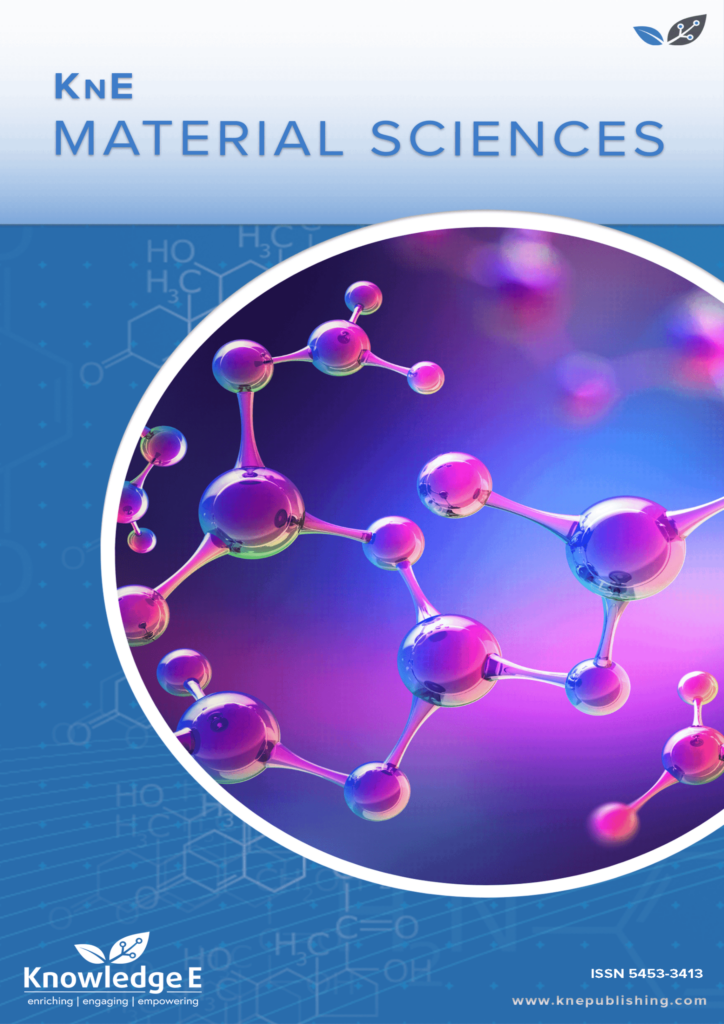
KnE Materials Science
ISSN: 2519-1438
The latest conference proceedings on physical materials, energy materials, electrical materials.
Functionalization of Bacterial Cellulose With Bacterial Pigments: Optimization Using a Full Factorial Design Approach
Published date: Aug 10 2022
Journal Title: KnE Materials Science
Issue title: 1st International FibEnTech Congress (FibEnTech21) – New Opportunities for Fibrous Materials in the Ecological Transition
Pages: 54–62
Authors:
Abstract:
Pigments from natural sources, such as bacterial pigments, have gained increased attention in recent years due to their biodegradability, non-toxicity, and noncarcinogenicity. The intention to replace synthetic and oil-derived compounds is not restricted to synthetic dyes; other applications include the replacement of oilderived polymers for more environmentally friendly options, such as biopolymers. In this work, the functionalization of a bacterial cellulose (BC) biopolymer with bacterial pigments was explored using a full factorial design methodology to evaluate the best functionalization conditions to produce colored BC. From the factors and interactions evaluated, it was possible to conclude that the variable duration of the functionalization procedure could be reduced to a low level without significantly affecting the functionalization of the BC samples with bacterial pigments. Moreover, BC is a product with high industrial applicability, versatility, and sustainability. Hence, the multifunctional colored BC can be applied in the packaging, paper, and textile industries, among others.
Keywords: bacterial pigments, bacterial cellulose, full-factorial design, optimization
References:
[1] Slama HB, Bouket AC, Pourhassan Z et al. Diversity of synthetic dyes from textile industries, discharge impacts and treatment methods. Applied Sciences. 2021;11:6255-6276. https://doi.org/10.3390/APP11146255
[2] Oliveira MEP, Silva WMB, Alves DR, Neto JBA, Morais SM, Pinheiro SO. Dyes and pigments used in foods: An integrative literature review. Research, Society and Development. 2021;10:e316101018925-316101018949. https://doi.org/10.33448/rsdv10i10.18925
[3] Gičević A, Hindija L, Karačić A. Toxicity of azo dyes in pharmaceutical industry. IFMBE Proceedings. 2019;73:581–587. https://doi.org/10.1007/978-3-030-17971-7_88
[4] Ramesh C, Vinithkumar NB, Kirubagaran R, Venil CK, Dufossé L. Multifaceted applications of microbial pigments: Current knowledge, challenges and future directions for public health implications. Microorganisms. 2019;7:186-232. https://doi.org/10.3390/microorganisms7070186
[5] Mona S, Bajar S, Deepak B, Kiran B, Kaushik A. Materials for biomedical engineering. Grumezescu V, Grumezescu AM, editors. Elsevier; Amsterdam, Netherlands, 2019.
[6] Seddiqi H, Oliaei E, Honarkar H et al. Cellulose and its derivatives: Towards biomedical applications. Cellulose. 2021;28:1893–1931. https://doi.org/10.1007/S10570-020- 03674-W
[7] Emmanuel E, Yong LL, Asadi A, Anggraini V. Full-factorial two-level design in optimizing the contents of olivine and coir fiber for improving the strength property of a soft marine clay. Journal of Natural Fibers. 2020:19(2):1–16. https://doi.org/10.1080/15440478.2020.1751373
[8] Giacomelli F. Avaliação das condições de crescimento da serratia plymuthica para produção de prodigiosina. University of Beira Interior; Covilhã, Portugal, 2018.
[9] Ahmad WA, Yusof NZ, Nordin N, Zakaria ZA, Rezali MF. Production and characterization of violacein by locally isolated Chromobacterium violaceum grown in agricultural wastes. Applied Biochemistry and Biotechnology. 2012;167:1220– 1234. https://doi.org/10.1007/s12010-012-9553-7
[10] Venil CK, Zakaria ZA, Usha R, Ahmad WA. Isolation and characterization of flexirubin type pigment from Chryseobacterium sp. UTM-3T. Biocatalysis and Agricultural Biotechnology. 2014;3:103–107. https://doi.org/10.1016/j.bcab.2014.02.006
[11] Elkenawy NM, Yassin AS, Elhifnawy HN, Amin MA. Optimization of prodigiosin production by serratia marcescens using crude glycerol and enhancing production using gamma radiation. Biotechnology Reports Journal. 2017;14:47–53. https://doi.org/10.1016/j.btre.2017.04.001
[12] Mendes A, Carvalho J, Duarte M. Factorial design and response surface optimization of crude violacein for Chromobacterium violaceum production. Biotechnology Letters. 2001:23(23):1963–1969. https://doi.org/10.1023/A:1013734315525
[13] Cheng K-C, Catchmark JM, Demirci A. Effect of different additives on bacterial cellulose production by Acetobacter xylinum and analysis of material property. Cellulose. 2009;16:1033–1045. https://doi.org/10.1007/s10570-009-9346-5
[14] Bingol D, Tekin N, Alkan M. Brilliant yellow dye adsorption onto sepiolite using a full factorial design. Applied Clay Science. 2010;50:315–321. https://doi.org/10.1016/j.clay.2010.08.015
[15] Hu X, Wang H, Liu Y. Statistical analysis of main and interaction effects on Cu(II) and Cr(VI) decontamination by nitrogen–doped magnetic graphene oxide. Scientific Reports. 2016;6:34378-34389. https://doi.org/10.1038/srep34378